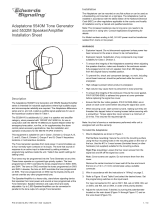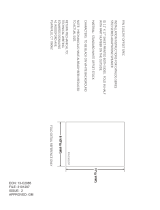Page is loading ...

© 2015 UTC Fire & Security Americas Corporation, Inc. 1 / 4 P/N 3100358-EN • REV 03 • ISS 16JAN15
5532MD Series Adaptatone Speaker-
Amplifier Installation Sheet
Description
The 5532MD Series Adaptatone Speaker-Amplifier is a UL and cUL
Listed audible signal appliance that is designed to accept system audio
input levels of 10 VRMS (5532MD-10AW) or 70 VRMS
(5532MD-70AW), making it possible to interface to public address
systems where area-wide system audio is required. The units are also
diode polarized for use in fire alarm applications.
Additionally, the 5532MD Series units are UL and cUL listed for use in
the hazardous locations shown in Table 1.
The speaker-amplifier is a heavy-duty, stand-alone signaling device
that operates from local power and sounds a tone programmed at the
tone generator. The speaker direction and output level are easily
adjustable.
This equipment is suitable for use in Class I, Division 2, Groups A, B,
C, and D; Class II, Division 2, Groups F and G; and Class III
hazardous locations or nonhazardous locations.
Installation
Install and wire this device in accordance with applicable national and
local codes, ordinances, and regulations.
When the signal is used in a fire protective signaling system, you must
install it in accordance with these instructions, and with the applicable
requirements of NFPA 70 and 72 in the US or CAN/ULC-S524 and
CSA C22.1 in Canada.
When the device is used in general signaling applications, you must
install it in accordance with these instructions, and with the applicable
requirements of NFPA 70 in the US or CSA C22.1 in Canada.
When the device is used in Division 2 applications, you must install it in
accordance with the NFPA 70 Article 501-4b.
The Adaptatone can be mounted on any flat surface or can be used as
a freestanding unit mounted on a rigid pipe. The Adaptatone must be
installed by a trained and qualified electrician.
WARNINGS
• Explosion hazard. Do not disconnect equipment unless power has
been removed or the area is known to be nonhazardous.
• Explosion hazard. Substitution of any components may impair
suitability for Class I, Division 2.
• To ensure the integrity of the Adaptatone assembly when adjusting
the speaker direction, make sure threads in the enclosure remain
fully engaged and do not turn speaker more than 360 degrees
from the original factory installed position.
• To prevent fire, shock and component damage, no work, including
circuit board removal, should be performed while the circuit is
energized.
• High voltage is present when product is energized.
• High volume may cause harm to personnel in close proximity.
• To ensure the integrity of the enclosure: Make sure that the cover
gasket, P/N P-007549-0069, is adhered into the groove at the
cover perimeter before replacing the signal box cover.
• Ensure that the four collar gaskets, P/N P-041930-0362, are in
place on each cover screw before securing the signal box cover.
• When securing the cover, start the screws by hand, making sure
that they are threaded into the tapped holes in the housing bosses
before securing them with a screwdriver. Torque the signal box
cover screws to a minimum of 20 in-lbs. This ensures the required
tight fit.
Caution: During installation, care must be taken so that components
on the printed circuit board are not damaged.
Notes
• Any kind of service or maintenance performed while unit is
energized will void the warranty.
• The increased resistance due to long wire runs needs to be
accounted for in sizing wire. Consult Applications Engineering for
details.
To install the Adaptatone:
1. Mount Adaptatone as shown in Figure 1.
Flat Surface mounting: Secure the unit to the mounting surface
using the four mounting holes in the mounting plate on the rear of
the box. Use the #10 x 3 wood screws (furnished loose) or other
hardware (not supplied) suitable for the mounting surface.
Rigid Pipe mounting: Loosen the four cover screws from the
signal box and lift off the signal box cover.
Note: The cover screws are captive. Do not remove them from the
cover.
Remove the center knockout in lower wall of the box and mount
the box on a 1/2 in. conduit pipe using a suitable connector.
2. Wire in accordance with the instructions in “Wiring” on page 2.
3. Adjust the volume level, if desired, by turning the potentiometer
located on the main board (Figure 6).
4. Tightly secure the signal box cover using the four retained cover
screws.
5. Torque the signal box cover screws to a minimum of 20 in-lbs.
6. To adjust the speaker direction, the loosen large star nut (Figure 1)
and turn the speaker to the approximate desired position
Regardless of the speaker direction adjustment, it is important that
the star nut be tightened wrench-tight to ensure the speaker
position is maintained securely.
7. Verify operability.

2 / 4 P/N 3100358-EN • REV 03 • ISS 16JAN15
Figure 1: Mounting the Adaptatone
(1) Speaker
(2)
Large star nut to adjust
speaker direction
(3)
Signal box
(4)
Cover screws (4X)
(5)
Collar gaskets (4X)
(6) Mounting plate
(7) #10 × 3 screws or hardware
suitable for the mounting
surface
(8
) Raceway and connections
(not supplied) to 1/2 in.
knockout hole
Wiring
WARNING: To prevent fire and shock, wire the Adaptatone only as
described in this installation instruction.
Caution: Risk of system failure. Electrical supervision requires that the
wire run be broken at each terminal. Do not loop the field wires around
the terminals.
Note: Terminal Block TB1 can be unplugged from the main board to
complete wiring as shown in Figure 2.
To wire the Adaptatone:
1. Install wires through a knockout hole in the bottom of the box from
a raceway that is, with its connections to the 1/2 in. conduit
knockout hole, approved for the same degree of protection and
enclosure type needed by the application. Use the plastic cable
ties, on the barrier to the electronics, to separate incoming power
leads from signal and tone initiating leads, per NEC (Figure 4).
2. Wire as follows referring to Figure 4.
a. Connect the green and yellow striped earth ground wires to
earth ground.
b. See Figure 4 and Figure 5. Connect the audio in (+) and (−) to
the AUD (+) and (−) terminals (respectively) on the speaker-
amplifier audio coupler board. Use shielded cable and connect
the braid or drain to the earth ground wire on the unit.
c. Connect wires leading to the next signal or end-of-line resistor
to TB1 terminals 1 and 2 on the main board as shown in
Figure 3. Polarity must be observed.
d. Optional. Connect an external 24 VDC battery (not supplied) in
series with the separate diode assembly (P/N 2600010,
supplied) to TB1 terminals 3 and 4 on the main board as
shown in Figure 3 and marked on the diode assembly.
Figure 2: Terminal block TB1
(1) Terminal block (TB1)
(2) Main board
Figure 3: Wiring to terminal block TB1
(1) To next signal or end-of-line resistor
(2) From control panel signal circuit
(3) Diode assembly P/N 2600010
(4) To optional 24 VDC battery backup
Note: Polarity is shown in the alarm condition. The polarity is reversed
in the field wire monitoring the condition of the control panel.
Figure 4: Wiring the 5532M series speaker-amplifier
(1) Audio coupler board
(2) Plastic cable ties (provided) used to separate power leads from
signal and tone initiating leads
(3) Signal leads to be connected to the audio coupler board as
applicable
(4) +24 VDC wiring from the fire alarm control panel (FACP)
(1)
(2)
(3)
(4)
(5)
(3)
(4)
(5)
(6)
(7)
(8)
2
4
1
3
(1)
(2)
(2) (4)
2
1
3
4
(3)
(1)
(1)
(2) (4)
(3)(2)
(4)
(1)

P/N 3100358-EN • REV 03 • ISS 16JAN15 3 / 4
Figure 5: Wiring audio output of FACP to speaker-amplifier audio
coupler board
(1) AUD (Audio) +
(2) AUD (Audio) −
(3) Relay
(4) Power supervision (where applicable)
(5) Audio coupler board
(6) To other speaker-amplifier audio coupler boards
(7) Tone generator
Figure 6: 5532M Series PC board locations
(1) Audio input board
(2) Main board
(3) Direction of increasing volume
(4) Potentiometer for volume adjustment
Maintenance and testing
WARNING: To prevent fire, shock and component damage, no work,
including circuit board removal, should be performed while the circuit is
energized. Ensure that power is disconnected before cleaning the
inside of the unit.
Note: Any kind of service or maintenance performed while unit is
energized will void the warranty.
Examine the unit semiannually for accumulation of dirt. Clean it if
necessary.
The Adaptatone should be tested annually or as required by the
authority having jurisdiction to ensure continuous service.
Specifications
Voltage
Refer to Table 2
Current
Refer to Table 2
Dimensions
Refer to Table 3
Weight
9 lb. (4.1 kg)
Hazardous
locations [1]
Ambient temp.
−31 to 104°F (−35 to +40°C)
Nonhazardous locations
Variable ambient temp. −40 to 151°F (−40 to +66°C)
[1] Hazardous locations and variable ambient conditions apply only
where UL Listings are accepted.
Table 1: Hazardous locations
Model number
Hazardous location Temperature code
5532MD
-10AW
5532MD
-70AW
Class I, Div. 2,
Groups A, B, C, D
T3C (160°C, 320°F)
Class II, Div. 2, Groups F, G
Class III
T5 (100°C, 212°F)
Table 2: Electrical specifications
Voltage
Current (tone on)
20
VDC 0.63 A
24
VDC 0.74 A
28
VDC 1.0 A
31
VDC 0.85 A
20
VFWR 120 Hz 0.69 A
24
VFWR 120 Hz 0.79 A
Table 3: Speaker-amplifier dimensions
5532M
A
8-7/8 in. (225 mm)
B
8-1/4 in. (210 mm)
C
13 in. (330 mm)
Regulatory information
Ratings
ANSI/ISA 12.12.01
CAN/CSA C22.2 No. 25
CAN/CSA C22.2 No. 213
NEMA Type 3R
UL 464
UL 1480
Contact information
For contact information, see www.edwardssignaling.com.
(3)(4)
(2)
A B
(1)
(5)
(6)
(7)
(1)
(2)
(1)
(2)
(3)
(4)
A
B
C

4 / 4 P/N 3100358-EN • REV 03 • ISS 16JAN15
/



